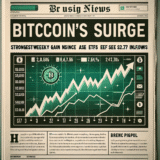Bitcoin Faces Headwinds as Goldman Sachs Adjusts Fed Rate Cut Timeline Following Strong Jobs Report
Bitcoin (BTC) kicked off the week on a downward trajectory as major investment banks recalibrated their expectations regarding Federal Reserve (Fed) rate cuts. This shift came on the heels of a robust jobs report released last Friday, which had significant implications for both traditional and cryptocurrency markets.
Bitcoin Dips Below $93,000 Amid Market Reassessment
During the European trading hours, Bitcoin’s price fell below the $93,000 mark, reflecting a 1.6% decrease on the day, according to data from CoinDesk. The cryptocurrency appears poised to test the support zone around $92,000, a price level that has consistently provided a safety net since late November. The broader cryptocurrency market, as reflected by the CoinDesk 20 Index, also saw a downturn, with losses exceeding 3%. Major coins such as XRP, ADA, and DOGE experienced even steeper declines.
Traditional Markets React to Employment Figures
In the realm of traditional markets, futures linked to the S&P 500 index traded 0.3% lower, indicating a continuation of Friday’s 1.5% drop that pushed the index to its lowest point since early November. The dollar index (DXY) approached 110 for the first time since late 2022, buoyed by elevated Treasury yields that further supported its gains.
Strong Jobs Report Influences Fed Rate Expectations
The employment data released on Friday revealed a significant increase in nonfarm payrolls, which rose by 256,000 in December—the largest gain since March. This figure exceeded expectations of 160,000 job additions and marked a considerable increase from the prior month’s figure of 212,000. Additionally, the unemployment rate improved from 4.2% to 4.1%, while average hourly earnings rose by 0.3% month-on-month and 3.9% year-on-year, slightly below expectations.
In response to this robust data, Goldman Sachs adjusted its forecast for the next Fed interest rate cut, now anticipated in June instead of March. In their Economic Research note to clients on January 10, Goldman stated, “Our economists now expect the Fed to cut just twice in 2025 (June/December vs. March/June/December previously), with another rate cut in June 2026.” This shift suggests that the Fed’s previous focus on inflation risks may be evolving.
Market Sentiment Shifts as Rate Cut Prospects Fade
The note further explained that while December’s Federal Open Market Committee (FOMC) decision indicated a significant shift towards prioritizing inflation, the latest jobs report may have solidified the Fed’s stance on interest rates. The softer average hourly earnings figure diminished concerns over a potential overheating job market. As a result, the case for rate cuts aimed at mitigating labor market risks has receded.
The Fed’s Rate-Cutting Cycle History
The Fed’s cycle of rate cuts began in September 2023, with a 50 basis point reduction in the benchmark borrowing cost. Subsequent months saw quarter-point cuts until December, which marked a pause in the cutting cycle to signal fewer rate reductions on the horizon for 2025. Notably, Bitcoin has surged over 50% since the first rate cut on September 18, reaching record highs above $108,000.
Bank of America Raises Concerns Over Rate Hikes
While Goldman Sachs and JPMorgan maintain a relatively optimistic outlook regarding future rate cuts, Bank of America (BofA) has expressed concerns about a prolonged pause, indicating that the risks may favor a rate hike or renewed tightening. The U.S. 10-year Treasury note yield, sensitive to interest rate and inflation expectations, has already risen by 100 basis points since the initial rate cut.
BofA analysts remarked, “We think the cutting cycle is over… Our base case has the Fed on an extended hold. But we believe the risks for the next move are skewed toward a hike.” This sentiment reflects a growing apprehension among analysts regarding economic stability and inflation control.
ING’s Perspective on Market Sentiment
ING analysts concurred, stating, “The market is right to see the risk of an extended pause from the Fed,” especially in light of recent economic data. They noted that this perspective may strengthen further if core inflation remains at 0.3% month-on-month for five consecutive months. The upcoming December consumer price index report, scheduled for release on January 15, will be crucial in shaping market expectations.
Potential Implications for Bitcoin and Cryptocurrency Markets
The evolving landscape of interest rates and economic indicators has profound implications for Bitcoin and the broader cryptocurrency market. As investors closely monitor the Fed’s decisions, the interplay between traditional finance and cryptocurrencies becomes increasingly significant.
For those interested in Bitcoin, understanding the factors influencing its price movements is essential. If you’re looking to invest in Bitcoin or other cryptocurrencies, it is crucial to stay informed about market trends, regulatory developments, and economic indicators. Resources such as How to Buy Bitcoin and How to Buy Cryptocurrency can guide you through the process.
Conclusion: Navigating the Future of Bitcoin in a Changing Economic Landscape
As Bitcoin grapples with market pressures stemming from altered Fed rate expectations, investors must remain vigilant. The interplay between economic data, interest rates, and cryptocurrency valuations will likely shape market dynamics in the coming months. Keeping abreast of these developments will be pivotal for anyone involved in Bitcoin or the wider cryptocurrency ecosystem.
To further deepen your understanding of the factors influencing cryptocurrency prices, consider exploring other resources and articles. Staying informed will empower you to make educated investment decisions as the landscape continues to evolve.
























